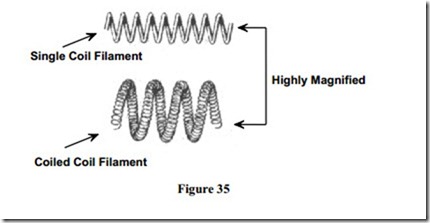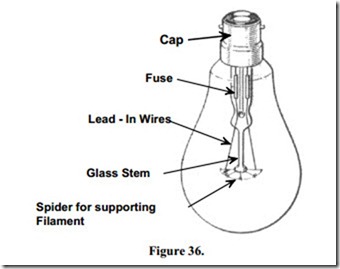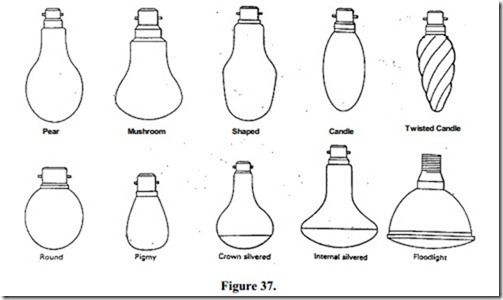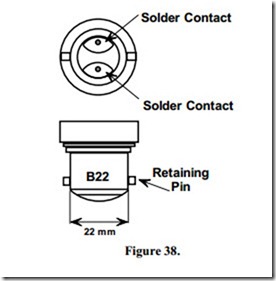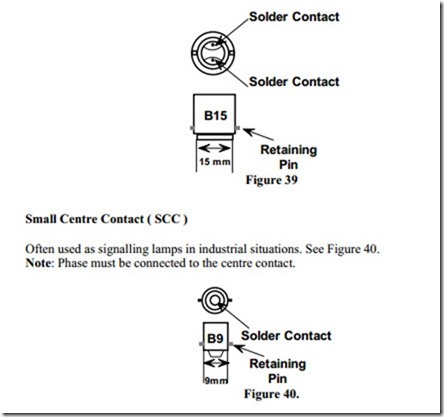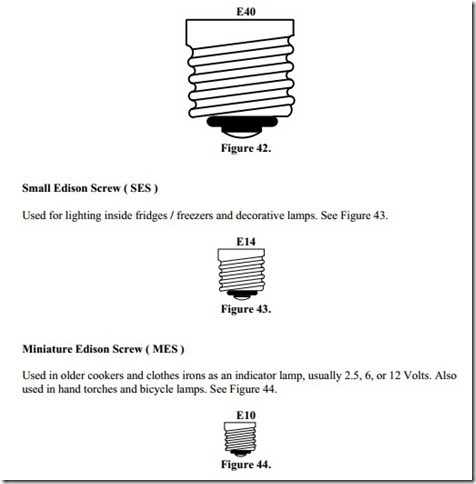The Incandescent Lamp
Lighting of the correct type and intensity is of great importance in both domestic and industrial environments as well as contributing to safety on our roads and streets.
The most commonly used lamp in domestic premises is known as the “incandescent lamp” or “tungsten filament lamp”. There are a number of these lamps in use and they are grouped together under the heading General Lighting Service ( GLS ) lamps.
These lamps operate on the principle that if a material is made “white hot” it will emit light.
Tungsten is chosen for the filament because of the following two properties:
· It has a high melting temperature ( 3380oC )
· It can be drawn into very fine wire
This very fine wire is wound in the form of a coil ( single coil filament ). This process is taken a step further by coiling the coil ( coiled coil filament ), which improves the efficiency further, especially for the smaller ranges of lamp ( below 150W ).
Figure 36 illustrates the filament supported on a metal spider, which is held by a glass stem and the whole arrangement is enclosed in a glass envelope, or bulb. The filament fuse is a valuable feature as it avoids possible disruptive arcing and the blowing of circuit fuses when a lamp fails.
There are two types of incandescent lamp:
· The Vacuum Lamp
· The Gas Filled Lamp
1. Vacuum Lamp
To prevent oxidisation and premature failure of the lamp filament, all oxygen has to be removed from the glass bulb. The filament is operated in a vacuum. The vacuum has the disadvantage that the filament vaporises at a lower temperature. This allows tungsten to condense on the internal surface of the bulb. The result is, blackening of the bulb and a consequent reduction of efficiency. The highest temperature at which it is possible to operate the filament is approximately 2100oC.
2. Gas Filled Lamp
To overcome the disadvantages of the vacuum lamp, a mixture of Argon and Nitrogen Gas is introduced into the bulb. This raises the operating temperature to 2500oC approx. before blackening takes place. To reduce excessive heat loss due to convection the filament is coiled. A thin layer of gas attaches itself to the filament. The convection current of gas glides over this fixed layer. The result is that only the outside of the coil is cooled.
The light output covers the visible spectrum giving a warm white to yellow light with good colour rendering. This means that the colours of articles viewed in the light of a GLS lamp are faithfully reproduced. The life expectancy of a modern GLS lamp is about 1,000 hours.
The GLS lamp is unchallenged as the domestic light source. Despite the availability of more efficient lamps there are more GLS lamps produced each year than any other type.
One factor which may have contributed to the popularity of the GLS lamp is that designers have been able to modify the glass envelope to give a very pleasing decorative appearance as shown in Figure 37.
There are many different lamp designs on the market today:
· double-life lamps with special coiled-coil filaments
· rough service lamps with special shock-resistant properties
· reflector lamps used for display lighting
· decorative lamps
· heating lamps and other lamps for special applications.
Filament lamps are best operated in their cap-up position.
For every 5% increase in steady operating voltage over the rated voltage, the life of the lamp is approximately halved.
Bulb Types
There are three main types of bulb:
Clear – a transparent bulb of clear glass, suitable for use in enclosed fittings where the bulb is not visible. This is to reduce glare.
Pearl – acid treated on the inside, which causes diffusion of the light and reduces glare, suitable for open-bottom type fittings.
Silica Coated – coated internally with a white silica compound and are usually mushroom shaped. They produce glare free light.
GLS lamps are also available in a variety of colours to provide festive lighting.
A much smaller version of the GLS known as a pygmy lamp is used in such places as fridges and ovens. These lamps are available in a range of colours and are often used to provide festive lighting. They may also be used where space is restricted or as indicator lamps.
Cap Types
Incandescent or tungsten filament lamps are classified according to the type of cap, by which they are connected to the supply. The two main types in use are the Bayonet Cap ( BC ) and the Edison Screw ( ES )
Bayonet Cap ( BC )
This is the most commonly used type where the filament ends terminate in raised solder contacts. These contacts connect to the corresponding pins in the lampholder and the lamp is held in position by the two retaining pins as shown in Figure 38.
Small Bayonet Cap ( SBC )
Used in modern decorative light fittings. See Figure 39.
In this type of lamp the cap is threaded and screws into an Edison Screw lampholder. One side of the filament is connected to a centre contact while the other side is connected to the brass cap. The phase conductor is connected to a corresponding contact at the back of the lampholder while the neutral is connected to the threaded part.
These lamps are manufactured in the same range as BC types and are frequently used for spot lighting, infra red and reflector applications. See Figure 41.
Goliath Edison Screw ( GES )
This is simply a larger version of the ES type ( both physically and electrically ). It is used for higher wattage lamps than the ES type, mainly for street lighting. See Figure 42.
Safety
Always ensure that the ES lampholder is correctly connected, otherwise a person removing or replacing the lamp could receive a serious shock from the threaded part of the lamp or lampholder.
Lamp Ratings
Lamps are rated according to their wattage.
BC Lamps are available in the following wattages: 15, 25, 40, 60, 75, 100, 150, 200 Watts.
ES Lamps are available in the same general range as BC but up to 300 Watts. GES Lamps are available up to 1500 Watts.
Lamp Life Span
The average life span of a tungsten filament lamp is 1000 hours, provided that it is used correctly. There are three main problems associated with tungsten filament lamps:
1. Vibration
2. Heat
3. Ventilation
1. Vibration
When the filament, which is extremely fine, is at operating temperature any vibration or mechanical shock can cause distortion of the coil and rapid burnout.
NEVER check a lamp to see if it has blown by vibrating it.
2. Heat
In normal service, the lamp dissipates heat. It is important that high temperatures are avoided, in fittings wholly or partly made from plastics. The manufacturer’s maximum permitted lamp wattage should not be exceeded. Most light fittings carry a label stating what this maximum wattage is. All too frequently users increase the wattage of the lamp, as the fittings will physically accept them. This practice should be avoided as it may be a fire hazard and also shortens the life of the lamp.
3. Ventilation
Enclosed fittings must have adequate ventilation otherwise the life of the lamp will be shortened.
